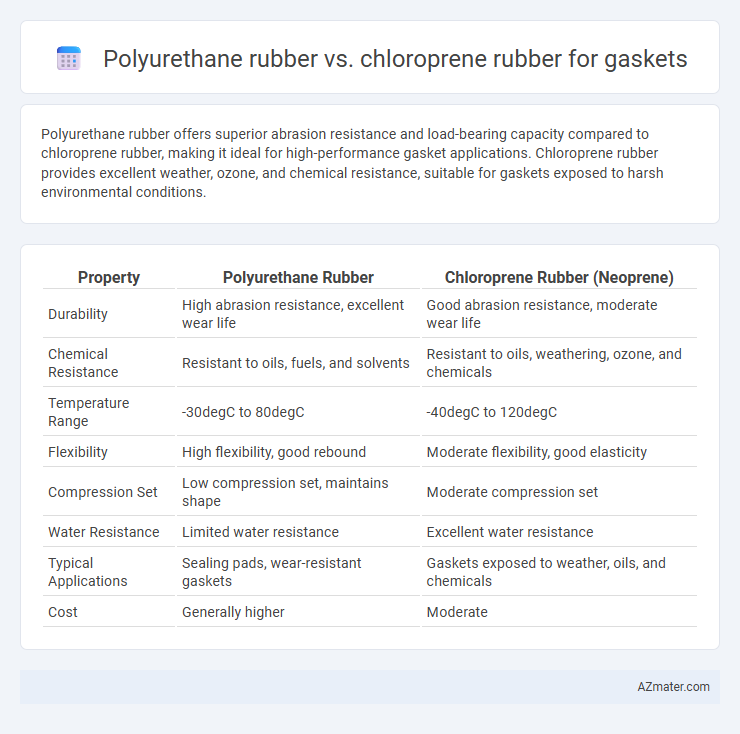Polyurethane rubber offers superior abrasion resistance and load-bearing capacity compared to chloroprene rubber, making it ideal for high-performance gasket applications. Chloroprene rubber provides excellent weather, ozone, and chemical resistance, suitable for gaskets exposed to harsh environmental conditions.
Table of Comparison
| Property | Polyurethane Rubber | Chloroprene Rubber (Neoprene) |
|---|---|---|
| Durability | High abrasion resistance, excellent wear life | Good abrasion resistance, moderate wear life |
| Chemical Resistance | Resistant to oils, fuels, and solvents | Resistant to oils, weathering, ozone, and chemicals |
| Temperature Range | -30degC to 80degC | -40degC to 120degC |
| Flexibility | High flexibility, good rebound | Moderate flexibility, good elasticity |
| Compression Set | Low compression set, maintains shape | Moderate compression set |
| Water Resistance | Limited water resistance | Excellent water resistance |
| Typical Applications | Sealing pads, wear-resistant gaskets | Gaskets exposed to weather, oils, and chemicals |
| Cost | Generally higher | Moderate |
Introduction to Polyurethane and Chloroprene Rubber
Polyurethane rubber offers exceptional abrasion resistance, high tensile strength, and excellent flexibility, making it ideal for gaskets in demanding mechanical environments. Chloroprene rubber (Neoprene) provides superior chemical stability, weather resistance, and moderate flexibility, ensuring reliable sealing in industrial and automotive applications. Both materials deliver unique performance benefits, with polyurethane excelling in wear resistance and chloroprene favoring chemical durability for gasket manufacturing.
Key Properties of Polyurethane Rubber
Polyurethane rubber offers exceptional abrasion resistance, high tensile strength, and excellent elasticity, making it ideal for durable gaskets in demanding environments. Its superior resistance to oils, solvents, and hydraulic fluids enhances gasket performance in industrial applications compared to chloroprene rubber. Additionally, polyurethane exhibits excellent tear resistance and low compression set, ensuring long-lasting seals and reliable mechanical integrity.
Defining Features of Chloroprene Rubber
Chloroprene rubber, also known as Neoprene, offers excellent chemical stability and maintains flexibility over a wide temperature range, making it ideal for gasket applications requiring resistance to oils, solvents, and weathering. Its inherent flame resistance and durability against environmental factors outperform many alternatives, including polyurethane rubber, which excels more in abrasion resistance and elasticity. The superior resistance of chloroprene rubber to aging, ozone, and UV exposure ensures long-lasting sealing performance in industrial gaskets.
Durability and Mechanical Performance Comparison
Polyurethane rubber offers superior abrasion resistance and tensile strength compared to chloroprene rubber, making it highly durable for gasket applications exposed to mechanical stress. Chloroprene rubber excels in chemical resistance and environmental stability but generally has lower tear strength and elasticity under high strain conditions. For gaskets requiring long-term mechanical performance under dynamic loads, polyurethane rubber typically outperforms chloroprene in wear resistance and load-bearing capacity.
Chemical Resistance Differences
Polyurethane rubber offers excellent resistance to oils, fuels, and abrasion, making it suitable for environments exposed to hydrocarbons but shows limited resistance to strong acids and bases. Chloroprene rubber (neoprene) exhibits superior chemical resistance to a broader range of substances, including acids, alkalis, and various solvents, making it ideal for gaskets in aggressive chemical environments. The choice between polyurethane and chloroprene for gaskets depends on the specific chemicals encountered, with chloroprene favored for harsh chemical resistance and polyurethane preferred for mechanical durability.
Temperature Tolerance and Environmental Stability
Polyurethane rubber offers excellent abrasion resistance and performs well within a temperature range of -40degC to 80degC, making it suitable for gaskets exposed to moderate temperatures. Chloroprene rubber demonstrates superior temperature tolerance, maintaining stability between -40degC and 120degC, and exhibits enhanced resistance to ozone, weathering, and chemicals, which is critical for gasket applications in harsh environments. Choosing Chloroprene rubber ensures better long-term environmental stability, while Polyurethane is preferred for applications prioritizing mechanical wear resistance.
Cost-Effectiveness and Availability
Polyurethane rubber offers excellent cost-effectiveness for gaskets due to its durability and resistance to abrasion, extending gasket life and reducing replacement frequency. Chloroprene rubber, while slightly more expensive, provides superior chemical resistance and flexibility, making it suitable for harsher environments but potentially increasing maintenance costs. Availability of polyurethane is generally higher in industrial markets, supporting faster procurement, whereas chloroprene may have limited suppliers depending on regional demand and specialty applications.
Applications in Gasket Manufacturing
Polyurethane rubber exhibits superior abrasion resistance and elasticity, making it ideal for gaskets in dynamic sealing applications such as hydraulic systems and automotive engines. Chloroprene rubber offers excellent chemical resistance and weatherability, preferred for gaskets exposed to oils, ozone, and extreme temperatures in industrial and marine environments. Manufacturers select polyurethane for durability under mechanical stress, while chloroprene is chosen for chemical stability and aging resistance in gasket production.
Pros and Cons: Polyurethane vs Chloroprene for Gaskets
Polyurethane rubber offers superior abrasion resistance, excellent tear strength, and high load-bearing capacity, making it ideal for gaskets exposed to mechanical stress. Chloroprene rubber provides good chemical resistance, moderate weather and ozone resistance, and maintains flexibility at low temperatures, suitable for gaskets in outdoor or chemical environments. However, polyurethane can degrade when exposed to UV light and certain chemicals, while chloroprene may suffer from lower abrasion resistance and shorter lifespan under heavy mechanical wear.
Which Rubber Material is Best for Gasket Use?
Polyurethane rubber offers superior abrasion resistance and high tensile strength, making it ideal for gaskets exposed to mechanical wear and dynamic pressure. Chloroprene rubber (Neoprene) excels in chemical stability and weather resistance, suitable for gaskets in environments with oils, solvents, and ozone exposure. For gasket applications requiring durability against physical stress, polyurethane is preferred, whereas chloroprene is best for chemical and environmental resilience.

Infographic: Polyurethane rubber vs Chloroprene rubber for Gasket
 azmater.com
azmater.com